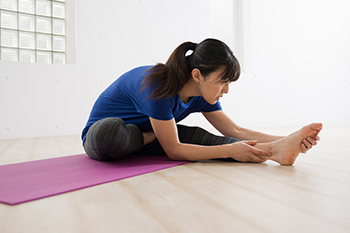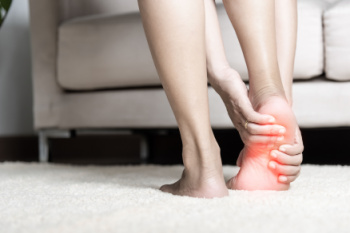Blog
Stretching Exercises The May Improve Plantar Flexion

Plantar flexion, the action of pointing the toes away from the body, is vital for everyday activities like walking and driving. Weakness in plantar flexion can lead to changes in gait, tightness in the lower back muscles, and stiffness in the calf muscles. Incorporating specific foot exercises into your routine is a good way to improve plantar flexion. Try the downward ankle stretch, holding the foot in a pointed position for 30 to 60 seconds while seated or standing, and rotate the ankle for added benefit. Another effective exercise involves tracing the alphabet with each foot while seated, promoting muscle engagement and flexibility. For added resistance, loop an exercise band over the toes, slowly pointing and flexing the feet against the resistance. Performing these exercises three to five times per week can improve plantar flexion strength and enhance lower limb function. Strengthening plantar flexion can contribute to better mobility, reduced discomfort, and improved overall quality of life. Before starting a new exercise program, particularly if you have pre-existing foot or ankle conditions, it is suggested that you consult a podiatrist.
Exercising your feet regularly with the proper foot wear is a great way to prevent injuries and build strength. If you have any concerns about your feet, contact one of our podiatrists from Pennsylvania. Our doctors can provide the care you need to keep you pain-free and on your feet.
Exercise for Your Feet
Exercise for your feet can help you gain strength, mobility and flexibility in your feet. They say that strengthening your feet can be just as rewarding as strengthening another part of the body. Your feet are very important, and we often forget about them in our daily tasks. But it is because of our feet that are we able to get going and do what we need to. For those of us fortunate enough to not have any foot problems, it is an important gesture to take care of them to ensure good health in the long run.
Some foot health exercises can include ankle pumps, tip-toeing, toe rises, lifting off the floor doing reps and sets, and flexing the toes. It is best to speak with Our doctors to determine an appropriate regimen for your needs. Everyone’s needs and bodies are different, and the activities required to maintain strength in the feet vary from individual to individual.
Once you get into a routine of doing regular exercise, you may notice a difference in your feet and how strong they may become.
If you have any questions please feel free to contact one of our offices located in Plymouth Meeting and Ambler, PA . We offer the newest diagnostic and treatment technologies for all your foot and ankle needs.
Why Does My Heel Hurt?

Heel pain, a common ailment affecting people of all ages, can be attributed to various factors and conditions. One prevalent cause is plantar fasciitis, where the thick band of tissue connecting the heel bone to the toes becomes inflamed due to excessive strain or overuse. This condition often manifests as stabbing pain in the bottom of the foot, especially with the first steps in the morning or after long periods of rest. Another reason behind heel pain is Achilles tendinitis, characterized by inflammation of the Achilles tendon, which connects the calf muscles to the heel bone. This condition typically results from overuse, sudden increases in physical activity, or inadequate stretching. Additionally, heel spurs, bony growths that develop on the underside of the heel bone, can cause discomfort and irritation, especially while walking or standing for extended periods. Understanding the underlying causes of heel pain is critical for a proper diagnosis and treatment. If you have heel pain, it is suggested that you visit a podiatrist who can accurately determine what the cause is, and guide you toward the treatment method that is right for you.
Many people suffer from bouts of heel pain. For more information, contact one of our podiatrists of Pennsylvania. Our doctors can provide the care you need to keep you pain-free and on your feet.
Causes of Heel Pain
Heel pain is often associated with plantar fasciitis. The plantar fascia is a band of tissues that extends along the bottom of the foot. A rip or tear in this ligament can cause inflammation of the tissue.
Achilles tendonitis is another cause of heel pain. Inflammation of the Achilles tendon will cause pain from fractures and muscle tearing. Lack of flexibility is also another symptom.
Heel spurs are another cause of pain. When the tissues of the plantar fascia undergo a great deal of stress, it can lead to ligament separation from the heel bone, causing heel spurs.
Why Might Heel Pain Occur?
- Wearing ill-fitting shoes
- Wearing non-supportive shoes
- Weight change
- Excessive running
Treatments
Heel pain should be treated as soon as possible for immediate results. Keeping your feet in a stress-free environment will help. If you suffer from Achilles tendonitis or plantar fasciitis, applying ice will reduce the swelling. Stretching before an exercise like running will help the muscles. Using all these tips will help make heel pain a condition of the past.
If you have any questions please contact one of our offices located in Plymouth Meeting and Ambler, PA . We offer the newest diagnostic and treatment technologies for all your foot and ankle needs.
Why Does My Heel Hurt?

Heel pain, a common ailment affecting people of all ages, can be attributed to various factors and conditions. One prevalent cause is plantar fasciitis, where the thick band of tissue connecting the heel bone to the toes becomes inflamed due to excessive strain or overuse. This condition often manifests as stabbing pain in the bottom of the foot, especially with the first steps in the morning or after long periods of rest. Another reason behind heel pain is Achilles tendinitis, characterized by inflammation of the Achilles tendon, which connects the calf muscles to the heel bone. This condition typically results from overuse, sudden increases in physical activity, or inadequate stretching. Additionally, heel spurs, bony growths that develop on the underside of the heel bone, can cause discomfort and irritation, especially while walking or standing for extended periods. Understanding the underlying causes of heel pain is critical for a proper diagnosis and treatment. If you have heel pain, it is suggested that you visit a podiatrist who can accurately determine what the cause is, and guide you toward the treatment method that is right for you.
Many people suffer from bouts of heel pain. For more information, contact one of our podiatrists of Pennsylvania. Our doctors can provide the care you need to keep you pain-free and on your feet.
Causes of Heel Pain
Heel pain is often associated with plantar fasciitis. The plantar fascia is a band of tissues that extends along the bottom of the foot. A rip or tear in this ligament can cause inflammation of the tissue.
Achilles tendonitis is another cause of heel pain. Inflammation of the Achilles tendon will cause pain from fractures and muscle tearing. Lack of flexibility is also another symptom.
Heel spurs are another cause of pain. When the tissues of the plantar fascia undergo a great deal of stress, it can lead to ligament separation from the heel bone, causing heel spurs.
Why Might Heel Pain Occur?
- Wearing ill-fitting shoes
- Wearing non-supportive shoes
- Weight change
- Excessive running
Treatments
Heel pain should be treated as soon as possible for immediate results. Keeping your feet in a stress-free environment will help. If you suffer from Achilles tendonitis or plantar fasciitis, applying ice will reduce the swelling. Stretching before an exercise like running will help the muscles. Using all these tips will help make heel pain a condition of the past.
If you have any questions please contact one of our offices located in Plymouth Meeting and Ambler, PA . We offer the newest diagnostic and treatment technologies for all your foot and ankle needs.

